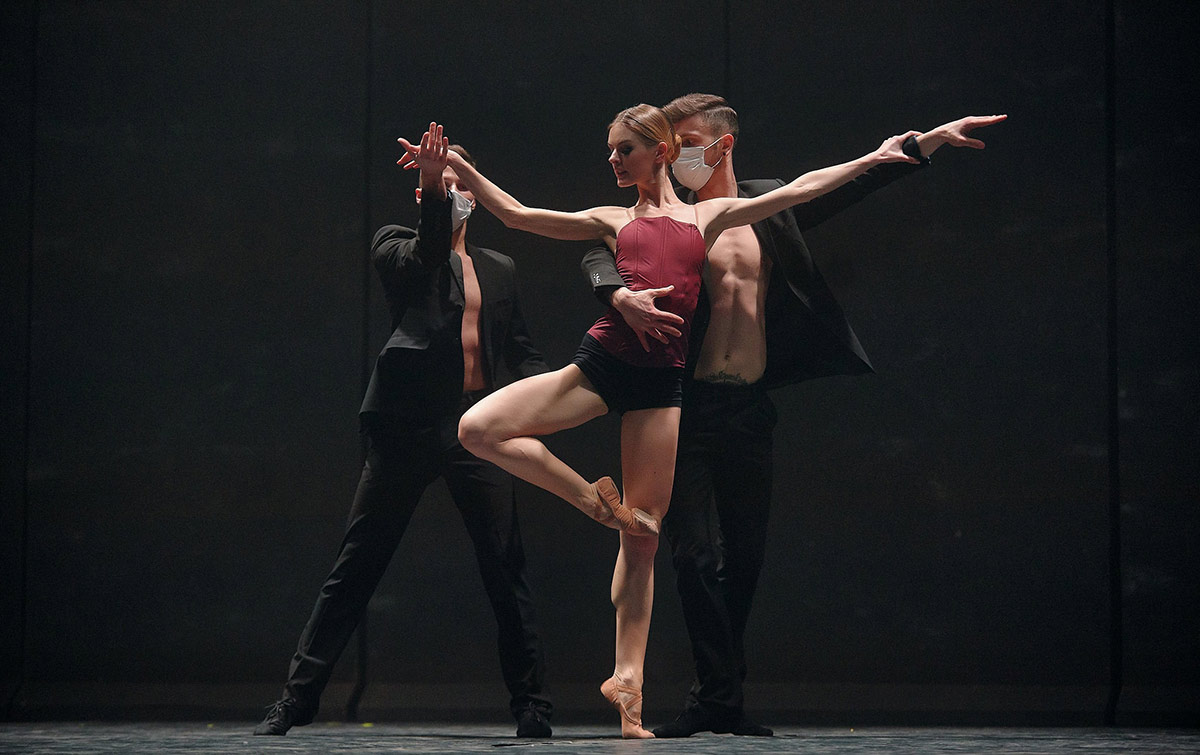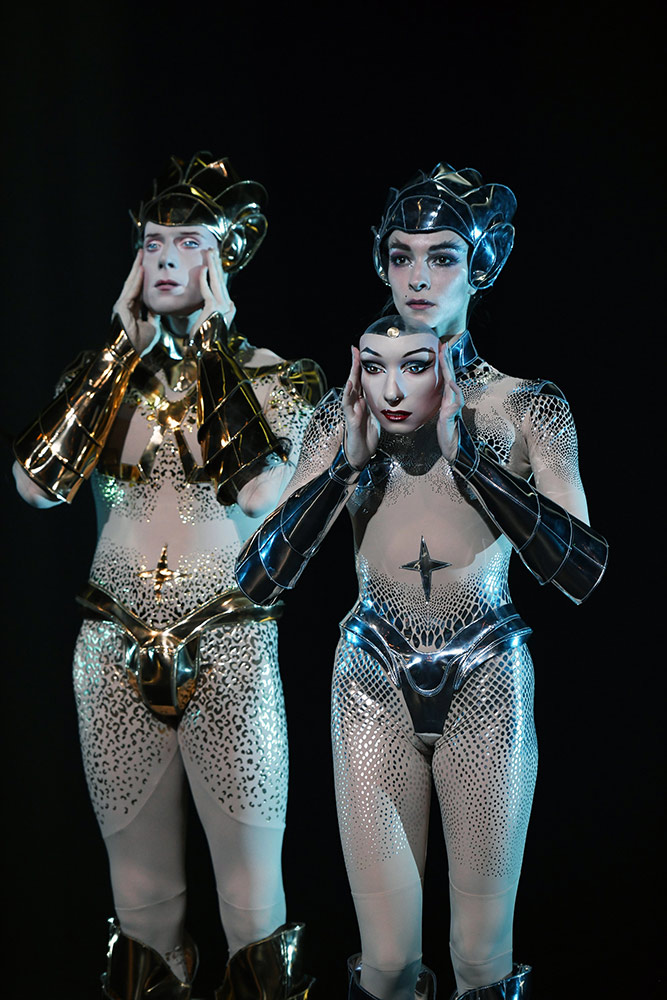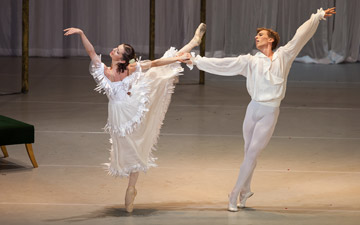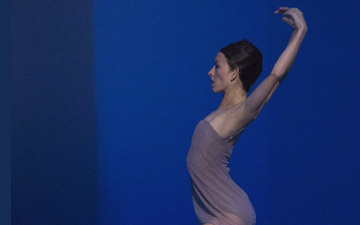
© Sasha Gusov. (Click image for larger version)
MuzArts
Radio & Juliet, Faun, McGregor + Mugler
★★✰✰✰
London, Coliseum
7 December 2019
www.facebook.com/muzarts.ballet
londoncoliseum.org
In a triple bill at the London Coliseum, presented by Russian production company MuzArts, there was certainly some spectacle and some good dancing, and not just from the big stars. However, the most heavily promoted piece and world premiere, that of the collaboration between choreographer, Wayne McGregor and designer, Manfred Thierry Mugler, was an excruciating fifteen minutes of disappointment, of which more, later.
The evening opened with Romanian born Edward Clug’s Radio & Juliet, loosely based on Shakespeare’s Romeo and Juliet, with musical accompaniment by early Radiohead. Clug, who first joined the SNG Maribor Ballet as a dancer in 1991 and later became its director in 2003, is very widely respected as a choreographer internationally, so it was about time his work graced a London stage. His Radio & Juliet, now performed all over the world, was created in 2005 for his company and surprisingly, looks very fresh and of the moment. With clips of film supporting the action on stage, the vocabulary is comprised of slick, jerky movements that nevertheless retain a certain fluidity in transition.

© Maximov. (Click image for larger version)
The cast was made up of Romeo (Denis Matvienko guesting from the Mariinsky Ballet), five further male dancers from the SNG Maribor Ballet and the exquisite Katja Khaniukova, English National Ballet first soloist, as Juliet. It was a little long at just under an hour, occasionally losing momentum, but it was a thought-provoking perspective. The men, dressed in black suits and bare-chested, were first-rate and very exciting. Though it was not clear narrative, and the piece is retrospective, there were obvious parallels drawn at various junctures throughout. Juliet’s first solo introduces Khaniukova as a vulnerable, diminutive girl, dressed in a corset – this immediately sets her apart as a target, a sparsely clothed female among the suited men. Her first duet with Matvienko was intriguing. As their attraction developed, there were times when their bodies were drawn close together, like magnets, but didn’t quite connect. This was not so much a romance as primal instinct. One section showed the men moving like quick-silver, combative during street encounters, where Mercutio meets his death – it was relayed later on screen to add extra dramatic punch. As we leap forward to Romeo’s death, Juliet, much more feisty by this stage, in a quirky departure from the play, decides to live on without Romeo. Clug was way ahead of his time, as we are now experiencing the advent of a new West End musical, & Juliet, which explores this very theme of Juliet opting out of suicide and the ‘what if…?’ scenario. Matvienko and Khaniukova were outstanding within a very strong cast and one would hope that we will see more of Clug’s work in the UK in the future.

© Batya Annadurdyev. (Click image for larger version)
The second half began with Sidi Larbi Cherkaoui’s Faun, a piece which I very much enjoyed when I saw Royal Ballet Flanders dance it a few years ago. Using Debussy’s L’Après-midi d’un faune, interspersed with a little of Nitin Sawney’s additional music, it was left to Bolshoi Ballet’s Anastasia Stashkevich and Vaycheslav Lopatin to embody this unusual choreography. Both gave excellent performances, Lopatin finding exactly the right balance between gangly innocence and feral needs, with Stashkevich breathing a sense of wonderment into her role. Best moments included a passage when they were intertwined, palms of hands and soles of feet, exploring touch and then Lopatin’s seeming lack of boney structure as his body melted from one phrase to the next.
After a brief pause, McGregor + Mugler, got underway. As if the title was enough to put bums on seats, within seconds I was shrinking down into mine. Garish designs made The Royal Ballet’s Edward Watson and Bolshoi’s prima ballerina Olga Smirnova, look faintly ridiculous. What were the M & M team thinking of? Gods or gladiators or possibly a remake of Barbarella – big, gawdy helmets and face masks of their own faces, nipples and overly large codpieces or G-strings, navels with crosses slapped onto snakeskin unitards – gold for Watson and silver for Smirnova. It was difficult not to fear that feet or arms would get caught up in shin pads and lower arm tat! With over amplified music by Holly Herndon and Nils Frahm, the limited choreography bore no relation to it. As parts of the costumes came off or in some cases possibly fell off, we saw the beautiful physiques of the protagonists, but with such limited vocabulary it was difficult to appreciate their magnificent talents. Masks whipped off, Watson dons hers for a bit (spooky), she doesn’t bother with his. They both do a bit of solo work, were not stretched at all and then the moment we’ve all (not) been waiting for, the helmets come off to reveal a sort of ‘punk meets My Little Pony’ hair do – and in a cruel twist of fate, Watson’s looked as if it had been planted on his head back to front.

© Sasha Gusov. (Click image for larger version)
All credit to Watson and Smirnova for maintaining their composure and offering as gracious a performance as they were able, but I would question just how much real thought had gone into it and whether or not the directors thought that they could cobble something together and get away with it on the strength of their reputations – which may now have plummeted. The crowd went mad at the end (although the first two pieces were infinitely superior) so perhaps I am simply the grumpy old woman that thinks that ballet is still an art form, not an expensive gimmick. Why put two of the greatest ballet dancers in the world through that? I felt sorry for the woman next to me who was experiencing a live ballet performance for the first time: incredibly excited at the start; completely baffled and crest-fallen at its close.

















You must be logged in to post a comment.